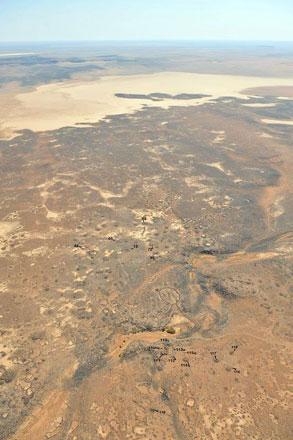You are here
Ancient inscriptions suggest Black Desert was once full of wildlife, vegetation
By Suzanna Goussous - Nov 30,2016 - Last updated at Nov 30,2016

Stones with Safaitic transcriptions and drawings of animals and nature unearthed in Azraq's Jabal Qurma area (Photo courtesy of Jebel Qurma Archaeological Landscape Project)
AMMAN — Local archaeologists, in cooperation with members of the Jebel Qurma Archaeological Landscape Project, have recently discovered stones that date back to 2,000 years in Jordan’s Black Desert, near Azraq area.
The project, which has been on archaeological missions since 2012, aims at “studying the extraordinary archaeological heritage in Jordan’s Black Desert”, according to their website. The excavations have uncovered around 5,000 stone pieces so far.
Head of the Zarqa Department of Antiquities (DoA) office, Romel Gharib, said the archaeological mission was part of an annual series of activities to discover the nature of wildlife throughout the region’s history.
The petroglyphs on the stones found in Azraq’s Jabal Qurma area narrate stories of residents of Jordan and Syria, Gharib added, noting that they are transcribed in the Safaitic alphabet, which was a south Semitic writing system used by the ancient nomads.
Jabal Qurma, located some 50km east of Azraq, has volcanic stones that date back to the Stone Age, with drawings that describes humans’ relationship with nature in the southern area of the Levant carved into them, the DoA official told The Jordan Times on Wednesday.
The area links Jordan, Syria, Saudi Arabia and Iraq, and its stones hold narratives of humans in the 1st century AD, with images featuring natural elements, Gharib added.
Some of the petroglyphs depict wildlife scenes, including animals such as camels, ostriches, gazelles, horses, lions and trees, he said, which implies that the area was once a green landscape, filled with vegetation and wild creatures living alongside human beings.
The DoA, in cooperation with the Royal Society for the Conservation of Nature, is planning to renovate a space at Jabal Qurma to promote ecotourism and enable researchers to come to the area within the next few months, according to Gharib.
“We aim to turn part of the location into an area for ecotourism, without changing the general form and landscape of the area,” he added.
Although the Kingdom boasts a number of unearthed archaeological sites, the expert said Jordanian archaeologists lack the needed support, in addition to having a limited budget and job opportunities.
“In order to embark on an archaeological mission to unearth ancient ruins, they have to have cameras, specialised tools and a good budget, in addition to a team of workers. This kind of budget is not available in Jordan,” Gharib added.
Related Articles
AMMAN — The Jabal Qurma Archaeological Landscape Project started in 2012, with extensive field surveys and excavations in the basalt desert
AMMAN — The inhabitants of the inhospitable Black Desert were often overlooked or wrongly perceived by contemporaries from ancient political
AMMAN — “The question of why there are no gazelles represented in the petroglyphs [designs pecked into a stone surface] remains puzzling,” s














